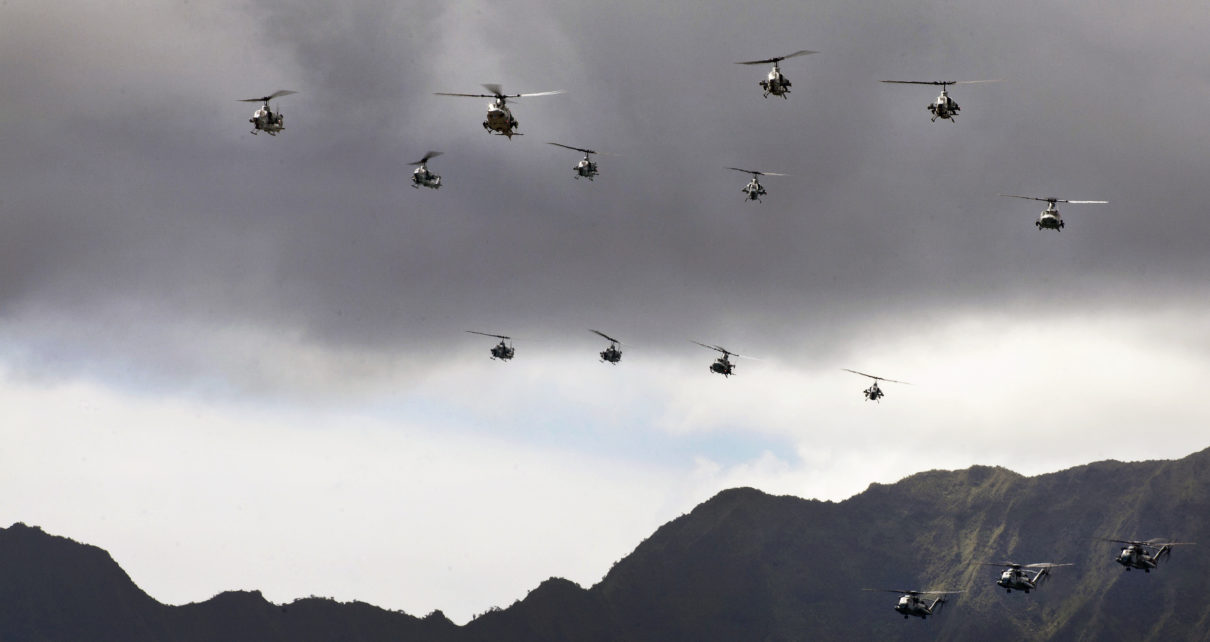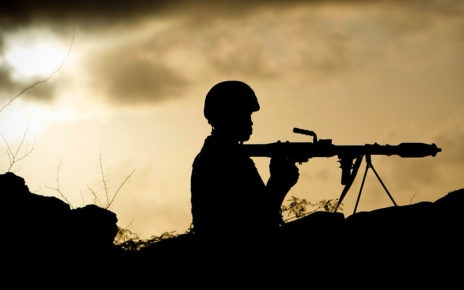Music has had an illustrious history in war. Historians have traced its impact to before the Mehter bands of the Ottoman Empire. Whether it is the iconic “Ride of the Valkyries” scene from Apocalypse Now and “Fortunate Son’s” guitar riff complementing the sound of the UH-1 in Forrest Gump, or the Red Army Choir blaring the chorus to the “Song of the Volga Boatmen,” music has contributed to military culture. Music is often used to advance a particular message or amplify certain emotions to shape public perceptions of war.
By 1964, for instance, the protest movement against the Vietnam War had taken to music to articulate its message. From Folk to Psychedelic Rock to Soul Music, the stark opposition to the war spanned many genres and artists. Ironically, the conflict became intrinsically tied to the anti-war music that vehemently opposed it. Footage of the US involvement in the conflict has been defined by hits such as The Rolling Stones’ “Gimme Shelter” and Crosby, Stills, Nash and Young’s “Ohio.”
This function of music transcends cultures and political boundaries. Jihadi movements and Al-Qaeda splinter groups have popularized the use of Nasheeds. To diversify their organizations, many Jihadi groups produced these theologically-charged chants as the soundtrack to their insurgency. At the height of its power, ISIS directed its very own media foundation to create these hymns to promote its cause.
But music has an even more direct relationship to war, one that blurs its cultural and conventional lines: its deployment as a weapon on the battlefield over the centuries. Middle Eastern armies had a tradition of using the Shawm and other loud double-reed instruments as psychological weapons and a way to disrupt the enemy’s communications. Non-combatants in Saracen armies wielded the instrument in the thousands, and when playing it simultaneously, produced a continuous eerie sound that unnerved their European counterparts during the Crusades.
It has since become possible to generate higher-decibel sounds due to technological breakthroughs, particularly in loudspeakers. Many NATO members have made strides in developing sonic weapons that can disperse crowds and cripple the enemy’s ability to fight. Examples of the modern use of music in a military capacity by NATO member states include the 1989 invasion of Panama to depose General Manuel Noriega. When Noriega was given asylum at the Holy See’s Papal Nunciature in Panama City, the US army decided to blare rock music non-stop to pressure the dictator into surrendering. The siege featured hits like Van Halen’s “Panama,” among other favorites by Guns N’ Roses and The Doors. It took ten days for Noriega to finally give in because he had taken prior Psyops training in the US.
Since the Invasion of Panama, the US military has increasingly relied on music as a weapon. With loudspeakers mounted on Humvees, the US army used Metallica and AC/DC against the Iraqis in the Battle of Fallujah. Similarly, US troops in Afghanistan deployed rock music at Marjah against the Taliban in 2010. The troops blasted songs like Offspring’s “Pretty Fly for a White Guy” so loudly that it could be heard two kilometres away and often pushed insurgents to lay down their arms. Music has recently been used in emerging tactics like cyber warfare. In mid-2012, Iran’s Natanz and Fordo nuclear facilities were hit by a cyber attack that triggered their computers to play AC/DC.
Other NATO states have followed suit. In 2013, the British Merchant Navy used Britney Spears to ward off pirates off the Horn of Africa. The security team used hits like “Baby One More Time” because the Somali pirates are known to despise western music, making such Pop classics ideal weapons. With the development of Long Range Acoustic Devices (LRADs), commercial cruise lines have adopted similar tactics to ensure their safety in the region. Major non-NATO allies have also used music as a weapon. The Israeli Defense Forces have used heavy metal in combat, such as in its 2002 operations against Fatah and Hamas militants that had occupied the Church of the Nativity.
There are two main components that make this function of music so successful: the range of decibels and the demoralization factor. Firstly, most LRADs equipped for commercial or military use range over 160 decibels of noise. In comparison, any sound above 120 decibels is expected to cause pain. These sound cannons are capable of causing permanent hearing damage, excruciating headaches, and vision loss. Documenting the IDF’s use of LRADs against protesters in 2005, the Toronto Star’s Middle Eastern bureau reported that “the knees buckle, the brain aches, the stomach turns, and suddenly nobody feels like protesting anymore.” The second factor concerns the use of specific songs that are meant to have a psychological impact on the enemy. As in the case against Somali pirates, certain songs are picked based on an adversary’s aversion to particular cultures and musical tastes. But there is also a demoralizing effect when one’s opponent forgoes conventional weapons and tactics and instead relies on a non-lethal alternative like music.
Despite its effectiveness and non-lethal impact, many critics oppose the weaponization of music. While this application arguably differs from the use of songs as a psychological torture mechanism in interrogation, others do not accept this distinction. Critics perceive this function of music as one that corrupts its innocent nature. However, to the soldiers on the battlefield, the weaponization of music may serve a different purpose. One that replaces the sound of bombs with the sound of the guitar riff in Black Sabbath’s “Paranoid” and, ultimately, provides an escape from the conventional horrors of war.
Photo: A still from a Marine training exercise titled “Ride of the Valkyries,” recalling Apocalypse Now via Flickr (Marines) Licensed Under United States Government Work.
Disclaimer: Any views or opinions expressed in articles are solely those of the authors and do not necessarily represent the views of the NATO Association of Canada.




